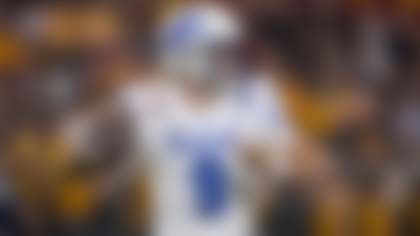It was easy to understand Keenan Lewis' plaintive Instagram post last week. As one, two, three, four and more teammates were released or traded by the New Orleans Saints during a massive makeover, Lewis, a native of the Big Easy, suggested that maybe his time with the team should come to an end, too, unless his contract was guaranteed.
At last check, Lewis is still on the roster, although the eye-blurring pace of New Orleans transactions to start free agency suggests he and everyone else should check back frequently with the brain trust in Metairie. And therein lies what makes the Saints' seismic shift so startling: The people who assembled the old roster -- head coach Sean Payton and general manager Mickey Loomis -- are the same ones disassembling it and rebuilding it with an entirely different identity.
After all, it was Loomis and Payton who, after a bruising contract fight, made Jimmy Graham the highest-paid tight end in the NFL a scant eight months ago. Graham's trade to the Seattle Seahawks was the most shocking move of what might have been the wildest five minutes in offseason history last Tuesday. At first, it seemed that Graham was the victim of a salary-cap crunch in New Orleans that had been several years in the making. But as the days wore on, and the deals kept developing -- including fairly sizable ones for Brandon Browner, C.J. Spillerand Dannell Ellerbe -- the Saints' bigger motive became clearer: Spurred by the money squeeze and the gross disappointment of last season, they are in the midst of a dramatic course correction, the kind that is usually reserved for franchises in the throes of a regime change.
That is what we are watching this spring in Philadelphia, where Chip Kelly, now fully in charge of personnel as he enters his third season with the Eagles, has cleared out many of the stars of the Andy Reid-led years and installed players he prefers. The same can be said for San Francisco, where a post-Jim Harbaugh overhaul is hitting the 49ers' defense especially hard. There has been no such front-office shakeup, of course, in New Orleans -- Payton is entering his ninth season as the head coach and Loomis has been general manager since 2002. Instead, Loomis laid out the thinking after the Graham trade in a SiriusXM Radio interview.
"At the end of the day, it comes down to this: We've had a good offensive team for a number of years," Loomis said. "We do well on that side of the ball, but we've got to improve ourselves on defense."
It doesn't take much reading between the lines there. The explosiveness of a Drew Brees-led offense has been fun to watch and is hard to leave behind, but last year, it simply didn't produce the desired results, in large part because the defense was abysmal. The sorry state of the D (31st in yards allowed, 28th in points allowed) coupled with poor pass protection took a toll on Brees, who turned the ball over 20 times in a highly disappointing 7-9 campaign. By the end of last week, the Saints' intentions were in better focus: This will be a much different looking -- and, they hope, better -- team, with a shored-up defense and an offense that Payton can scheme into success.
You can question individual moves New Orleans has made -- Why trade Darren Sproles last year, only to sign Spiller, who is the same kind of dual-threat running back with a higher price tag? Why decommit from Graham so soon after committing to him? -- but not the urgency. Brees is 36 with a contract that will draw scrutiny because of its onerous cap implications; in 2016, the final year of his current deal, his cap number will be more than $27 million, according to overthecap.com.
Payton has never been afraid of outside-the-box decisions. After all, the Saints won their only Lombardi Trophy in part because of his decision to try an onside kick to open the second half of the Super Bowl. Payton and Loomis have long enjoyed the support of owner Tom Benson, who, while in the midst of an ugly family battle over the future of the team, has shown no inclination to question its leadership. Winning the Super Bowl bought Loomis and Payton Benson's trust and loyalty, even at the franchise's most recent low point -- Bountygate -- and while the Saints have yet to mount another deep playoff push following that successful 2009 title run, they've missed the postseason only once since then with Payton on the sideline (he was suspended for the entire 2012 season).
In short, the team has been respectable but not championship-caliber. And even though Payton and Loomis are the ones who got New Orleans into this salary-cap and roster conundrum in the first place, they have earned the opportunity to fix their errors. But if this incarnation doesn't yield results? Then Benson and the Saints might be faced with even more difficult decisions -- whether it is time to move on from Brees and even potentially from Payton.
A decision on Brees might have to be made as soon as next season, at least in terms of reworking his contract to find a more palatable salary-cap impact. That gives the Saints a kind of soft deadline to see results.
But undoubtedly adding to the decision to veer toward dramatic change: the 2014 Saints' play in an eminently winnable NFC South, which was taken by the 7-8-1 Carolina Panthers. Even a moderately better defense -- merely below average instead of awful -- would have likely put the Saints in the playoffs instead of the Panthers. That would have still left New Orleans hovering somewhere around mediocrity, though, and Payton and Loomis are clearly thinking bigger. These are moves designed not to win the NFC South -- a little nibbling around the edges of the roster probably could have accomplished that -- but to return the Saints to the upper echelon of the conference, with the Packers and Seahawks. That ambition is to be applauded.
Most intriguing is that, during this bloodletting, New Orleans has also stockpiled the NFL's most powerful currency: draft picks. The Saints now have nine for this year, including two in the first round and two in the third. That gives them tremendous flexibility -- to move up in the first round, to trade back and accumulate more picks, to parlay these picks into more for future years. Those are critical assets for the longer-term future of the roster. But it also means that whatever identity the Saints emerge from this offseason with will be the one they are invested in for at least a few years. No draft Loomis and Payton have overseen in New Orleans has ever been as important and intriguing.
Few regimes, after all, get a chance to reinvent themselves as dramatically as the Saints are doing now. None get a third crack at it.
Follow Judy Battista on Twitter @judybattista.












